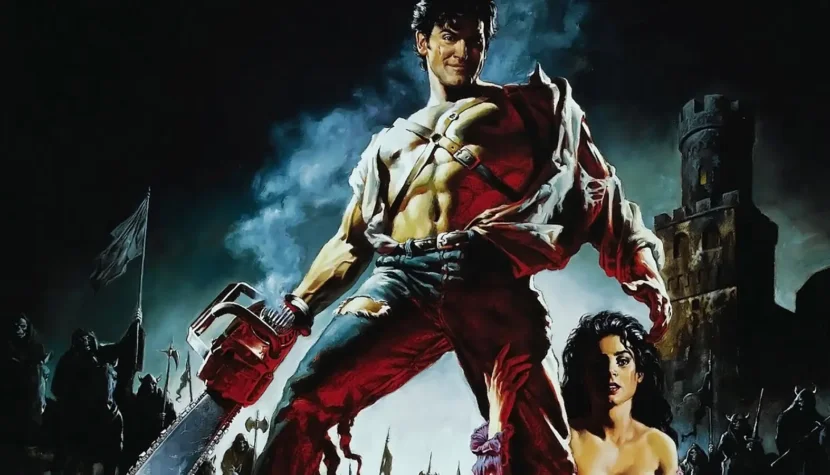ARMY OF DARKNESS. Groovy

Warning: Cult Classic! Army of Darkness, the third installment of the legendary series about a man destined to battle demons. Meet a character almost as iconic as Indiana Jones or John McClane. It’s said that his one-liners, used in school, at work, or on dates, can conquer any challenge. Plus, he’s arguably the most endearing grump and braggart ever brought to cinema. For many viewers, this chapter was their introduction to the series, and they fell in love. A geyser of wild ideas, dark humor, logic-defying scenes, and a comic book-like style left a lasting impression. Alongside Braindead (similar in style and era), this title showed millions that cinema could be juvenile, ridiculous, and so offbeat that it wipes school, teachers, and authority figures from your mind, leaving only pure fun.
After Ash Williams is sucked into a mysterious vortex, he’s transported from his woodland cabin to the Middle Ages. There, he’s mistaken for the savior who, according to prophecy, will stop the evil forces plaguing the land. Armed with his shotgun (later dubbed the Boomstick), chainsaw, and car, Ash is sick of battling the undead and just wants to return to his own time. But someone has to crush the evil into dust…
The first Evil Dead film was a low-budget horror made by a group of young enthusiasts led by director Sam Raimi and actor Bruce Campbell. It was a dark horror with a grotesque atmosphere. The second installment, essentially a reboot, mixed horror with comedy. In Army of Darkness, Raimi pushed the boundaries even further. First, he moved out of the cabin. Second, he threw the protagonist into the past. Third, he used the new medieval setting to craft a blend of fantasy, adventure, and horror, wrapped in such a thick layer of comedy that nothing here is serious. The gore is dialed down, but the pace is relentless, and the higher budget adds an epic quality. Raimi parodies costume dramas and knightly tales more than he indulges in them, but compared to the confined slaughter of earlier films, there’s a wealth of new material—more characters, outdoor scenes, battle sequences, and even a romance. The story adopts a more conventional tone, yet it retains grotesque angles, wild camera movements, and over-the-top shots of Ash’s screaming face. The result is a lively but balanced adventure style.

This stylistic shift revitalized the series (how long can you stay in a cabin?) and brought the fun into a fresh, surprising dimension. It also gave each Evil Dead installment a unique flavor while maintaining the series’ internal consistency. Raimi once again masterfully controls the material, but his vision wouldn’t work as well without its indispensable second component: Bruce Campbell. He was born to annihilate evil with a chainsaw. Campbell’s exaggerated expressions—his handsome yet cartoonishly elastic face—make him the Jim Carrey of horror. Remember when he smashed plates over his head in Evil Dead 2 or laughed maniacally alongside haunted antlers?
Ash is a gruff, arrogant buffoon—a grumpy, Elvis-like macho man with an authoritarian voice who sometimes sounds like Donald Duck. With his sharp chin, pointy nose, and spasm-prone body, he’s more a comic book figure than a flesh-and-blood hero. Campbell imbues this pop-culture creation with vitality and irony, turning Ash’s goofy lines into comedic gold. The character evolved through the series: first a terrified guy tripping over his own feet, then a slightly more competent version of that, and finally, in Army of Darkness, a hero—flawed but commanding—leading troops against the undead.
The battle scenes in Army of Darkness are pure cinematic delight. That we can invest in a fight between humans and quipping, bumbling skeletons is a testament to Raimi’s skill. He seizes every opportunity for a gag while ensuring the action remains spectacular and true to classic battle conventions. With a much larger budget (thanks to producer Dino De Laurentiis), Raimi included expansive, epic music by Joseph LoDuca (with one piece by Danny Elfman), adding grandeur akin to 1990s historical-adventure films.

The special effects are… fantastic. Both the creature makeup and stop-motion animation are stunning. Critics might call them cheap, artificial, or kitschy, but they’re exactly as they should be—playfully using kitsch to craft a vivid, cohesive, and enchanting world. These effects pay homage to retro aesthetics, particularly the adventure films of Ray Harryhausen, and are packed with unforgettable visuals (like the gothic windmill where Ash dispatches some particularly pesky undead). Sure, there are logical flaws—medieval language that’s not quite medieval, or the implausibility of crafting a mechanical hand in the Dark Ages—but spotting them is missing the point. Send your critiques to Raimi; maybe he’ll hire Nobel Prize-winning consultants next time.
Compared to its quirkier predecessors, this installment veers toward the mainstream, but on its own terms. Raimi, a horror visionary, crafted a film that seems ridiculous on the surface, but beneath the silly antics lies a love letter to pop culture and a robust cinematic heart. It doesn’t aim for subtlety—everything here growls, shrieks, and rumbles. Army of Darkness takes excess to the extreme and satisfies escapist fantasies with a world where anything is possible, and flying books, cackling skeletons, and surreal locations are the norm.
The film exists in several versions with notable differences. I recommend checking out the two main endings: the producer-mandated one and the director’s preferred, darker, funnier alternative. Raimi later took a more conventional Hollywood path (Spider-Man, for example), but this was his last “wild” production. It wasn’t, however, Ash’s final adventure. With a recent TV series continuing the demon slayer’s story and talk of a new movie, Ash’s legacy endures. Groovy, as the legendary Duke Nukem once said—though stealing that line from Ash deserves a chainsaw to the face.

